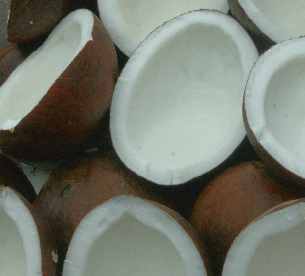
|
| Coconut trees commonly grow on tropical beaches |

|
| Ripening coconut fruits |
Cooks in tropical Asia make multiple uses of coconut products: Coconut water is
drunk directly out of the unripe fruit as a common refresher; the grated and
dried endosperm (khopra [खोपरा])
is used to thicken sauces and the oil
pressed from the endosperm is a popular frying medium. From the sweet juice
obtained by cutting young stems of several palm species (besides the coconut
palm, mostly the palmyra palm Borassus flabellifer and
particularly the kittul palm Caryota urens), the tasty palm
sugar is obtained (called gula merah red sugar
in Indonesia and
jaggery in India); alternatively, the sap can be fermented to yield
toddy (Indonesian: tuak), an alcoholic beverage. From
toddy, the highly intoxicating drink arrack is prepared by distillation,
and further fermentation of toddy gives the mild palm vinegar. Yet the coconut
product most important for cooking is coconut milk, called
ka thi [กะทิ] in Thailand,
nuoc cot dua [nước cốt dừa] in Vietnam,
santen in Indonesia and gata on the Philippines.
Coconut milk is made by processing grated coconut with hot water, thereby
extracting oil and aroma compounds. The result is a milky–white, opaque
emulsion (up to 20% fat) with a sweet coconut flavour. After some
time, fat and water may
separate (as in unhomogenized cow milk), yielding thick coconut cream
.

|
| To produce palm sugar, the sap must be boiled down |
Coconut milk is an extremely important ingredient for many cuisines of Asia. To
prepare it in a Western kitchen, the traditional, but time-consuming, method
may be emulated by blending desiccated coconut with hot water in a food
processor; even simpler is the use of industrially produced coconut extracts
(creamed coconut
), sold in blocks to be dissolved in hot water;
Gravies containing desiccated coconut are popular in Southern India (sometimes
in combination with yoghurt). Most famous for coconut usage is Kerala, a union
state in the very South West of India; people even say that there are as many
coconut trees in Kerala as stars in the sky. Desiccated coconut is commonly
ground together with asafetida, cumin, coriander seeds, chiles and toasted lentils or beans, yielding spice
pastes (masalas) characteristic of a particular dish. Coconut
oil is the most typical frying medium in Southern India.

|
| Coconut palm trees |
A typical example of a vegetarian specialty containing coconuts is
bisi bele or bese bele [ಬಿಸಿ ಬೇಳೆ] hot lentils
,
a rather dry dish made from vegetables, legumes and
rice; the recipe stems from Bangalore, capital of the Southern Indian union
state Karnataka. Boiled vegetables are mixed with puréed lentils and flavoured
with tart tamarind water and a sophisticated
spice mixture made from lentils, split peas, coriander,
cumin, fenugreek,
chiles and
shredded coconut toasted brown together with smaller quantities of cinnamon and cloves. After
steamed rice is added, the dish gets additional flavours from curry leaves fried shortly in butter (see ajwain on the topic of the co-called perfumed butter
or tadka [तड़का]).
Coconut chutney, named kobbari pachadi [కొబ్బరి పచ్చడి] in Telugu
and tengai togaiyal [தேங்காய் தொகையல்] in Tamil, is widely eaten in South India, always accompagnying the common breakfast breads
,
| |||||
|
Coconut products are ubiquitous in the cuisine of Sri Lanka, an island near India’s South Eastern shores. Hardly any of the curries Sri Lanka is famous for is made without at least a tablespoon of coconut milk, which at the same times thickens, gives more body and intensifies the flavour. Sri Lankan curries owe their character to coriander and cumin seeds, both of which are toasted to a dark brown before usage; further spices typical for this island are curry leaves, cinnamon and cardamom, more rarely pandanus leaves and lemon grass, all of which are native to Sri Lanka or at least widely cultivated. Chiles are used with a lavish hand.
The bowl-shaped breads typical for Sri Lanka, called hoppers (properly appam [අප්පම්, அப்பம்]), are composed of rice flour, coconut milk, and yeast (traditionally, fermenting coconut sap is used). From these ingredients, a thin pouring dough is made, which is then fried to a crisp texture in hemispherical pans. It is often eaten with another coconut concoction named pol sambol [පොල් සම්බෝල්] which is the Sinhalese version of coconut chutney: A moist and crumbly mass of freshly grated coconut seasoned with chile powder, chopped onions and lime juice.
Coconut is of eminent importance on the multitude of islands that belong to Indonesia. A specialty of the minangkabau people in Western Sumatra is rendang, beef or buffalo cubes cooked in coconut milk together with a multitude of spices (see greater galangale). Due to the long cooking period, even a tough bull is made tender, and a very unusual taste is achieved. In most other recipes, Indonesians prefer shorter cooking time when vegetables or meats are cooked in coconut milk.
A most exotic Indonesian recipe difficult to mimic outside the tropics is ayam pa’piong, a great invention of the toraja people living in the highland of Sulawesi. Here, cooking takes place inside a hollow bamboo stem: Chicken chunks, ginger, chives and lemon grass stalks are filled into a fresh bamboo stem together with grated coconut. The bamboo is sealed and heated moderately for several hours. When ready, the chicken is steamed to a tender texture, flavoured both by the coconut and the bamboo and emanating a faint lemon odour.
Even more coconut recipes are found at peninsular South East Asia, where Thai cooks add a new dimension to the art of cooking with coconut. In Thailand, the term curry (in Thai kaeng or gaeng [แกง]) almost always refers to food cooked in coconut milk. The aromatic pungency so much loved in Thailand is achieved by so-called curry pastes (gaeng prik): These preparations are ground mixtures of chiles with other fresh spices (e. g., ginger, fingerroot, galanga, garlic, onion), dried spices (cumin, coriander seeds) and typically shrimp paste or dried fish, enhanced with fragrant leaves like kaffir lime leaves, lemon grass and coriander leaves.
Several standard recipes of curry pastes are known by their colours. Green
curry paste (prik gaeng kiaw [พริกแกงเขียว])
contains green chiles, much
garlic and coriander
leaves. Red curry paste (prik gaeng dang [พริกแกงแดง])
is much hotter, as it derives its colour from ripe red chiles, which are
often dried and toasted before usage; an orange variant additionally contains
lots of fresh turmeric (yellow curry paste
,
prik gaeng liang [พริกแกงเหลือง]).
Lastly, there is the masaman curry paste, also written
massaman and matsaman
(prik gaeng masaman [พริกแกงมัสมั่น])
which is a slightly milder red paste that
additionally contains aromatic spices in the Indian fashion (cinnamon, cloves,
star anise; also toasted ground
coriander fruits); this recipe was introduced
to Thailand by Islâmic traders settling in Southern Thailand
(masaman derives from Muslim).
Once the curry paste is prepared, the further steps in making a Thai curry are quite simple: First, the curry paste may be fried in a little oil until it develops an aromatic smell. Some recipes omit this first step, but it does bring out more flavour with the masaman paste; with other pastes, the opinions about frying are more varied. Then the paste is dissolved in coconut milk and brought to a boil; only then, the other ingredients are added and cooked until tender. At last, the curry is seasoned with fish sauce (nam pla [น๊ำปลา]) and garnished with fresh basil leaves (or coriander leaves). A typical recipe might ask for beef or chicken meat and several types of vegetables (aubergines, potatoes, bamboo shoots). Thai curries have rather thin, almost soupy, structure.
Coconut milk does not only look like milk, but it may well used as an
alternative for milk in Western desserts (e. g., custards),
thus giving an extraordinary and exotic flavour. Coconut milk can also be
used in make ice creams (see vanilla).
Coconut aroma goes well with chocolate, but it may well be
combined with other spices to create unusual sweets. Indonesians use pandanus leaves for this purpose; I like it in
combination with tonka beans.













